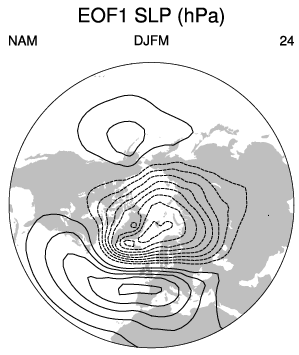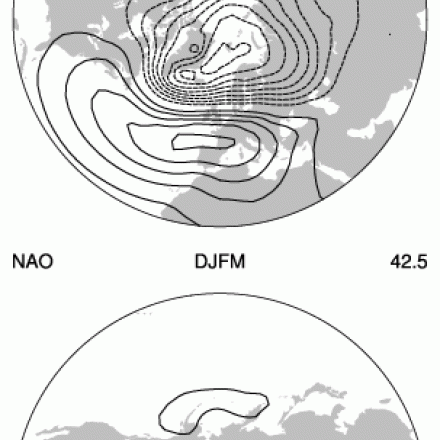Hurrell wintertime SLP-based Northern Annular Mode (NAM) Index

The NAM (or Arctic Oscillation) is defined as the first EOF of NH (20°-90°N) winter SLP data. It explains 23% of the extended winter mean (December-March) variance, and it is clearly dominated by the NAO structure in the Atlantic sector. Although there are some subtle differences from the NAO regional pattern over the Atlantic and Arctic (see Figure 1 below), the main difference is larger amplitude anomalies over the North Pacific of the same sign as those over the Atlantic. This feature gives the NAM a more annular (or zonally-symmetric) structure. Positive values of the NAM are associated with lower-than-normal sea level pressures over the Arctic and westerly wind anomalies along ~55º-60ºN.
Key Strengths
Long NAM Index extending back to 1899
Characterizes changes in the position and strength of the NH mid-latitude jet
Key Limitations
Physical distinction from NAO and North Pacific indices is not completely agreed upon by researchers
Dependent on any inherent weaknesses in the source data set and its gridding scheme
- DJFM Northern Annular Mode Index (SLP-Based)
Missing Value
-999Units
std.dev.Updated Through
2025-03-31Next Update
2026-05-01Start Date
1899-01-01File Notes
The DJFM PC index value for year N refers to an average of December year N-1 and January, February, and March year N SLP values prior to the EOF calculation. (Example: The 1999 PC value was based on the average of December 1998 and January, February, and March 1999 SLP values.)CAS Citation
NAM Index Data provided by the Climate Analysis Section, NCAR, Boulder, USA. Updated regularly. Accessed DD Month YYYY [list date you accessed the data].
Cite this page
Acknowledgement of any material taken from or knowledge gained from this page is appreciated:
Phillips, Adam & National Center for Atmospheric Research Staff (Eds). Last modified "The Climate Data Guide: Hurrell wintertime SLP-based Northern Annular Mode (NAM) Index.” Retrieved from https://climatedataguide.ucar.edu/climate-data/hurrell-wintertime-slp-based-northern-annular-mode-nam-index on 2025-12-25.
Citation of datasets is separate and should be done according to the data providers' instructions. If known to us, data citation instructions are given in the Data Access section, above.
Acknowledgement of the Climate Data Guide project is also appreciated:
Schneider, D. P., C. Deser, J. Fasullo, and K. E. Trenberth, 2013: Climate Data Guide Spurs Discovery and Understanding. Eos Trans. AGU, 94, 121–122, https://doi.org/10.1002/2013eo130001
Other Information
- Hurrell, J. W., and C. Deser, 2009: North Atlantic climate variability: The role of the North Atlantic Oscillation. J. Mar. Syst., 78, No. 1, 28-41
- Trenberth and Hurrell (1994): Decadal atmosphere-ocean variations in the Pacific, Climate Dynamics 9:303-319
- Thompson, D. W. J., J. M. Wallace and G. C. Hegerl, 2000: Annular modes in the extratropical circulation. Part I: Month-to-month variability. J. Climate, 13, 1000-1016.
- Hurrell, J.W., 1995: Decadal Trends in the North Atlantic Oscillation: Regional Temperatures and Precipitation. Science: Vol. 269, pp.676-679

